[English] 日本語
 Yorodumi
Yorodumi- EMDB-7046: BbRAGL-3'TIR synaptic complex with nicked DNA refined with C2 symmetry -
+ Open data
Open data
- Basic information
Basic information
| Entry | Database: EMDB / ID: EMD-7046 | |||||||||
|---|---|---|---|---|---|---|---|---|---|---|
| Title | BbRAGL-3'TIR synaptic complex with nicked DNA refined with C2 symmetry | |||||||||
 Map data Map data | BbRAGL-31TIR synaptic complex with nicked DNA refined with C2 symmetry | |||||||||
 Sample Sample |
| |||||||||
 Keywords Keywords | DNA transposase / DNA cut and paste transposition / DDE family RNase H fold DNA transposase / RECOMBINATION | |||||||||
| Function / homology |  Function and homology information Function and homology informationV(D)J recombination / RING-type E3 ubiquitin transferase / ubiquitin protein ligase activity / chromatin organization / endonuclease activity / histone binding / sequence-specific DNA binding / Hydrolases; Acting on ester bonds / hydrolase activity / protein homodimerization activity ...V(D)J recombination / RING-type E3 ubiquitin transferase / ubiquitin protein ligase activity / chromatin organization / endonuclease activity / histone binding / sequence-specific DNA binding / Hydrolases; Acting on ester bonds / hydrolase activity / protein homodimerization activity / zinc ion binding / nucleus Similarity search - Function | |||||||||
| Biological species |  | |||||||||
| Method | single particle reconstruction / cryo EM / Resolution: 4.3 Å | |||||||||
 Authors Authors | Zhang Y / Cheng TC | |||||||||
| Funding support |  United States, United States,  Romania, 2 items Romania, 2 items
| |||||||||
 Citation Citation |  Journal: Nature / Year: 2019 Journal: Nature / Year: 2019Title: Transposon molecular domestication and the evolution of the RAG recombinase. Authors: Yuhang Zhang / Tat Cheung Cheng / Guangrui Huang / Qingyi Lu / Marius D Surleac / Jeffrey D Mandell / Pierre Pontarotti / Andrei J Petrescu / Anlong Xu / Yong Xiong / David G Schatz /     Abstract: Domestication of a transposon (a DNA sequence that can change its position in a genome) to give rise to the RAG1-RAG2 recombinase (RAG) and V(D)J recombination, which produces the diverse repertoire ...Domestication of a transposon (a DNA sequence that can change its position in a genome) to give rise to the RAG1-RAG2 recombinase (RAG) and V(D)J recombination, which produces the diverse repertoire of antibodies and T cell receptors, was a pivotal event in the evolution of the adaptive immune system of jawed vertebrates. The evolutionary adaptations that transformed the ancestral RAG transposase into a RAG recombinase with appropriately regulated DNA cleavage and transposition activities are not understood. Here, beginning with cryo-electron microscopy structures of the amphioxus ProtoRAG transposase (an evolutionary relative of RAG), we identify amino acid residues and domains the acquisition or loss of which underpins the propensity of RAG for coupled cleavage, its preference for asymmetric DNA substrates and its inability to perform transposition in cells. In particular, we identify two adaptations specific to jawed-vertebrates-arginine 848 in RAG1 and an acidic region in RAG2-that together suppress RAG-mediated transposition more than 1,000-fold. Our findings reveal a two-tiered mechanism for the suppression of RAG-mediated transposition, illuminate the evolution of V(D)J recombination and provide insight into the principles that govern the molecular domestication of transposons. | |||||||||
| History |
|
- Structure visualization
Structure visualization
| Movie |
 Movie viewer Movie viewer |
|---|---|
| Structure viewer | EM map:  SurfView SurfView Molmil Molmil Jmol/JSmol Jmol/JSmol |
| Supplemental images |
- Downloads & links
Downloads & links
-EMDB archive
| Map data |  emd_7046.map.gz emd_7046.map.gz | 20.3 MB |  EMDB map data format EMDB map data format | |
|---|---|---|---|---|
| Header (meta data) |  emd-7046-v30.xml emd-7046-v30.xml emd-7046.xml emd-7046.xml | 19.3 KB 19.3 KB | Display Display |  EMDB header EMDB header |
| Images |  emd_7046.png emd_7046.png | 81.9 KB | ||
| Filedesc metadata |  emd-7046.cif.gz emd-7046.cif.gz | 6.9 KB | ||
| Archive directory |  http://ftp.pdbj.org/pub/emdb/structures/EMD-7046 http://ftp.pdbj.org/pub/emdb/structures/EMD-7046 ftp://ftp.pdbj.org/pub/emdb/structures/EMD-7046 ftp://ftp.pdbj.org/pub/emdb/structures/EMD-7046 | HTTPS FTP |
-Validation report
| Summary document |  emd_7046_validation.pdf.gz emd_7046_validation.pdf.gz | 547.4 KB | Display |  EMDB validaton report EMDB validaton report |
|---|---|---|---|---|
| Full document |  emd_7046_full_validation.pdf.gz emd_7046_full_validation.pdf.gz | 547 KB | Display | |
| Data in XML |  emd_7046_validation.xml.gz emd_7046_validation.xml.gz | 5.6 KB | Display | |
| Data in CIF |  emd_7046_validation.cif.gz emd_7046_validation.cif.gz | 6.4 KB | Display | |
| Arichive directory |  https://ftp.pdbj.org/pub/emdb/validation_reports/EMD-7046 https://ftp.pdbj.org/pub/emdb/validation_reports/EMD-7046 ftp://ftp.pdbj.org/pub/emdb/validation_reports/EMD-7046 ftp://ftp.pdbj.org/pub/emdb/validation_reports/EMD-7046 | HTTPS FTP |
-Related structure data
| Related structure data |  6b40MC  7043C  7044C  7045C M: atomic model generated by this map C: citing same article ( |
|---|---|
| Similar structure data |
- Links
Links
| EMDB pages |  EMDB (EBI/PDBe) / EMDB (EBI/PDBe) /  EMDataResource EMDataResource |
|---|---|
| Related items in Molecule of the Month |
- Map
Map
| File |  Download / File: emd_7046.map.gz / Format: CCP4 / Size: 22.2 MB / Type: IMAGE STORED AS FLOATING POINT NUMBER (4 BYTES) Download / File: emd_7046.map.gz / Format: CCP4 / Size: 22.2 MB / Type: IMAGE STORED AS FLOATING POINT NUMBER (4 BYTES) | ||||||||||||||||||||||||||||||||||||||||||||||||||||||||||||
|---|---|---|---|---|---|---|---|---|---|---|---|---|---|---|---|---|---|---|---|---|---|---|---|---|---|---|---|---|---|---|---|---|---|---|---|---|---|---|---|---|---|---|---|---|---|---|---|---|---|---|---|---|---|---|---|---|---|---|---|---|---|
| Annotation | BbRAGL-31TIR synaptic complex with nicked DNA refined with C2 symmetry | ||||||||||||||||||||||||||||||||||||||||||||||||||||||||||||
| Projections & slices | Image control
Images are generated by Spider. | ||||||||||||||||||||||||||||||||||||||||||||||||||||||||||||
| Voxel size | X=Y=Z: 1.35 Å | ||||||||||||||||||||||||||||||||||||||||||||||||||||||||||||
| Density |
| ||||||||||||||||||||||||||||||||||||||||||||||||||||||||||||
| Symmetry | Space group: 1 | ||||||||||||||||||||||||||||||||||||||||||||||||||||||||||||
| Details | EMDB XML:
CCP4 map header:
| ||||||||||||||||||||||||||||||||||||||||||||||||||||||||||||
-Supplemental data
- Sample components
Sample components
-Entire : BbRAGL-31TIR synaptic complex with nicked DNA
| Entire | Name: BbRAGL-31TIR synaptic complex with nicked DNA |
|---|---|
| Components |
|
-Supramolecule #1: BbRAGL-31TIR synaptic complex with nicked DNA
| Supramolecule | Name: BbRAGL-31TIR synaptic complex with nicked DNA / type: complex / ID: 1 / Parent: 0 / Macromolecule list: #1-#5 |
|---|---|
| Source (natural) | Organism:  |
| Molecular weight | Theoretical: 350 KDa |
-Macromolecule #1: RAG1L,RAG1L
| Macromolecule | Name: RAG1L,RAG1L / type: protein_or_peptide / ID: 1 / Number of copies: 2 / Enantiomer: LEVO |
|---|---|
| Source (natural) | Organism:  |
| Molecular weight | Theoretical: 74.440133 KDa |
| Recombinant expression | Organism:  Homo sapiens (human) Homo sapiens (human) |
| Sequence | String: ESLQRKRLCK ARLYDVTRHH VKHKRLKPLI EHIDEYCNEK DENKGDVLFF LLRSHLYDTG NRSMAEQIDT LWHGESLSCM TPEECLGMR LDMLMTKNQY SKEYNILKER GFSTLCPPKQ LDAIEKTLMP GTARYSIEGM DYSEHYFHSP VKMTGDLEVH S GETLEPDS ...String: ESLQRKRLCK ARLYDVTRHH VKHKRLKPLI EHIDEYCNEK DENKGDVLFF LLRSHLYDTG NRSMAEQIDT LWHGESLSCM TPEECLGMR LDMLMTKNQY SKEYNILKER GFSTLCPPKQ LDAIEKTLMP GTARYSIEGM DYSEHYFHSP VKMTGDLEVH S GETLEPDS VTMDFHEYVP DFPCPNTKGV RFPYAHAVAK TLEELEDEIV NGLKKLGRDP NDPTLVIHTI CKDGADGMGD VS VHKEKSD HLLPDKALRF SFCVLRCSVM HKDTEVTIYE DPNPNSVRSN RPVLECIGDE NDDGTVAVCV GPIECQRLLM KDK IMRVHM SDGTQRAHYL TFFNSMVDEK WDRAHGGLAG AGSKYLCTLC EAVRDEALEK AGSYKITRTL KKIEVTASKM KYES QEKDT FGVKGYPLLT TEPWERGIDA THTDINMGNY FKSLIVREMA QVHSWAKTAN VKKQIVDAES KLDKHLKESL GLNPT LMMA GNYARELFKA EHADKLVALV DKPDRKSALV EVLAKFRQLR KVYRANWPLN DMSDEVRQYK AKAVEMANDL KTHFPY APC TNYLHKVIEH VQELIEHPSG VGSVGALSSE GNEAGNKLFR QLRLGHARKG NTYNGLRDVL CTHWLYTSKT LRDKAA (UNK)(UNK)(UNK) (UNK)(UNK)(UNK)(UNK)(UNK)(UNK)(UNK)(UNK)(UNK)(UNK) (UNK)(UNK)(UNK) (UNK)(UNK)(UNK) UniProtKB: V(D)J recombination-activating protein 1 |
-Macromolecule #5: RAG2L
| Macromolecule | Name: RAG2L / type: protein_or_peptide / ID: 5 / Number of copies: 2 / Enantiomer: LEVO |
|---|---|
| Source (natural) | Organism:  |
| Molecular weight | Theoretical: 39.509254 KDa |
| Recombinant expression | Organism:  Homo sapiens (human) Homo sapiens (human) |
| Sequence | String: MSSGPIFSSL VTDSSRSSRK KSDSALGTEF TVVCDRVPLR DPSPTVQRFL CFVFDNGSGA MSTLPIDVGG EGISLSDMKE VKAMPHIAS GCTAVWGPPL PPKPGKDTKQ VILWGGLDKR RWCCSNDLTQ VDITITPKTT TAKVSILPAD KQDGVPSPRT G HTLVAISS ...String: MSSGPIFSSL VTDSSRSSRK KSDSALGTEF TVVCDRVPLR DPSPTVQRFL CFVFDNGSGA MSTLPIDVGG EGISLSDMKE VKAMPHIAS GCTAVWGPPL PPKPGKDTKQ VILWGGLDKR RWCCSNDLTQ VDITITPKTT TAKVSILPAD KQDGVPSPRT G HTLVAISS LQAILFGGLE LASRHARLGT CAQSCKDGYF YLLDMTTLRW NKLPLPPLVP RAYHSSTWVP ASSTMVIVGG IT YSGHCPS ERLSVSDVVC LKISDTSQYT LTEIHMEGVR DSYVSSSSAS ALCDDRFVLY GGYHHDKSGL HPPEPSRDLY VMN LQTKKA VVHHAPTRMA SAGHTCLRLI DNSVVMIGGT CKSVNCCTNL UniProtKB: RAG2L |
-Macromolecule #2: 31TIR intact strand
| Macromolecule | Name: 31TIR intact strand / type: dna / ID: 2 / Number of copies: 2 / Classification: DNA |
|---|---|
| Source (natural) | Organism:  |
| Molecular weight | Theoretical: 19.218312 KDa |
| Sequence | String: (DC)(DA)(DA)(DG)(DA)(DT)(DG)(DG)(DC)(DG) (DA)(DC)(DC)(DA)(DG)(DA)(DC)(DA)(DC)(DT) (DG)(DC)(DT)(DG)(DG)(DG)(DT)(DA)(DT) (DA)(DG)(DC)(DG)(DT)(DA)(DA)(DG)(DT)(DA) (DT) (DC)(DA)(DT)(DA)(DG)(DT) ...String: (DC)(DA)(DA)(DG)(DA)(DT)(DG)(DG)(DC)(DG) (DA)(DC)(DC)(DA)(DG)(DA)(DC)(DA)(DC)(DT) (DG)(DC)(DT)(DG)(DG)(DG)(DT)(DA)(DT) (DA)(DG)(DC)(DG)(DT)(DA)(DA)(DG)(DT)(DA) (DT) (DC)(DA)(DT)(DA)(DG)(DT)(DG)(DC) (DA)(DG)(DC)(DG)(DC)(DG)(DC)(DT)(DG)(DC) (DC)(DA) (DA)(DG) |
-Macromolecule #3: 31TIR pre-nicked strand of signal DNA
| Macromolecule | Name: 31TIR pre-nicked strand of signal DNA / type: dna / ID: 3 / Number of copies: 2 / Classification: DNA |
|---|---|
| Source (natural) | Organism:  |
| Molecular weight | Theoretical: 14.357206 KDa |
| Sequence | String: (DC)(DA)(DC)(DT)(DA)(DT)(DG)(DA)(DT)(DA) (DC)(DT)(DT)(DA)(DC)(DG)(DC)(DT)(DA)(DT) (DA)(DC)(DC)(DC)(DA)(DG)(DC)(DA)(DG) (DT)(DG)(DT)(DC)(DT)(DG)(DG)(DT)(DC)(DG) (DC) (DC)(DA)(DT)(DC)(DT)(DT)(DG) |
-Macromolecule #4: 31TIR pre-nicked strand of flanking DNA
| Macromolecule | Name: 31TIR pre-nicked strand of flanking DNA / type: dna / ID: 4 / Number of copies: 2 / Classification: DNA |
|---|---|
| Source (natural) | Organism:  |
| Molecular weight | Theoretical: 4.601971 KDa |
| Sequence | String: (DC)(DT)(DT)(DG)(DG)(DC)(DA)(DG)(DC)(DG) (DC)(DG)(DC)(DT)(DG) |
-Macromolecule #6: CALCIUM ION
| Macromolecule | Name: CALCIUM ION / type: ligand / ID: 6 / Number of copies: 2 / Formula: CA |
|---|---|
| Molecular weight | Theoretical: 40.078 Da |
-Macromolecule #7: ZINC ION
| Macromolecule | Name: ZINC ION / type: ligand / ID: 7 / Number of copies: 2 / Formula: ZN |
|---|---|
| Molecular weight | Theoretical: 65.409 Da |
-Experimental details
-Structure determination
| Method | cryo EM |
|---|---|
 Processing Processing | single particle reconstruction |
| Aggregation state | particle |
- Sample preparation
Sample preparation
| Concentration | 0.4 mg/mL |
|---|---|
| Buffer | pH: 7.6 |
| Grid | Model: C-flat-1.2/1.3 4C / Material: COPPER / Mesh: 400 / Pretreatment - Type: GLOW DISCHARGE / Pretreatment - Time: 45 sec. / Pretreatment - Atmosphere: AIR |
| Vitrification | Cryogen name: ETHANE / Chamber humidity: 100 % / Chamber temperature: 283 K / Instrument: FEI VITROBOT MARK III |
- Electron microscopy
Electron microscopy
| Microscope | FEI TITAN KRIOS |
|---|---|
| Specialist optics | Energy filter - Name: GIF Quantum LS / Energy filter - Lower energy threshold: 0 eV / Energy filter - Upper energy threshold: 20 eV |
| Image recording | Film or detector model: GATAN K2 SUMMIT (4k x 4k) / Detector mode: SUPER-RESOLUTION / Digitization - Dimensions - Width: 7676 pixel / Digitization - Dimensions - Height: 7420 pixel / Digitization - Frames/image: 3-40 / Number grids imaged: 1 / Number real images: 4429 / Average exposure time: 10.0 sec. / Average electron dose: 54.0 e/Å2 |
| Electron beam | Acceleration voltage: 300 kV / Electron source:  FIELD EMISSION GUN FIELD EMISSION GUN |
| Electron optics | Illumination mode: FLOOD BEAM / Imaging mode: BRIGHT FIELD / Cs: 0.01 mm / Nominal defocus max: 2.5 µm / Nominal defocus min: 1.2 µm / Nominal magnification: 81000 |
| Sample stage | Specimen holder model: FEI TITAN KRIOS AUTOGRID HOLDER / Cooling holder cryogen: NITROGEN |
| Experimental equipment |  Model: Titan Krios / Image courtesy: FEI Company |
+ Image processing
Image processing
-Atomic model buiding 1
| Refinement | Space: REAL / Protocol: FLEXIBLE FIT |
|---|---|
| Output model |  PDB-6b40: |
 Movie
Movie Controller
Controller


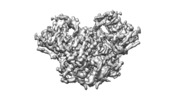


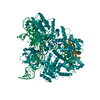
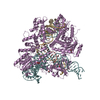
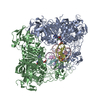
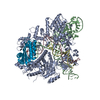


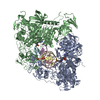


 Z (Sec.)
Z (Sec.) Y (Row.)
Y (Row.) X (Col.)
X (Col.)






















